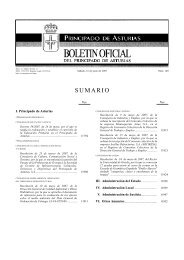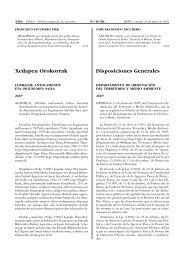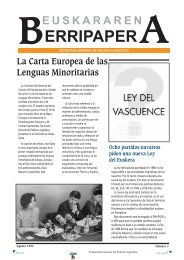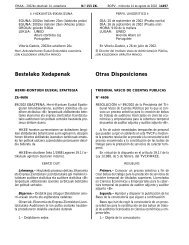258 <strong>Atxikimendu</strong>a, <strong>genero</strong> <strong>rolak</strong>, <strong>eta</strong> mendekotasuna Henderson, S. (1974). Care-eliciting behavior in man. Journal of Nervous and Mental Disease, 159, 172-181. Henderson, S. N., <strong>eta</strong> Cunningham, J. D. (1993). Women's emotional dependence on men: scale construction and Test of Russianoff's Hypothesis. Sex Roles, 28(5/6), 317-334. Hendrick, C., <strong>eta</strong> Hendrick, S. S. (1989). Research on love: Does it measure up? Journal of Personality and Social Psychology, 56(5), 784-794. Hiller, D. V., <strong>eta</strong> Philliber, W. W. (1985). Internal consistency and correlates of the Bem Sex Role Inventory. Social Psychology Quarterly, 48(4), 373-380. Hindy, C. G., <strong>eta</strong> Schwarz, J. C. (1984). Individual differences in the tendency toward anxious romantic attachments. Paper presented at the Second International Conference on Personal Relationships, Madison. Hindy, C. G., <strong>eta</strong> Schwarz, J. C. (1985). "Lovesickness" in dating relationships: An attachment perspective. Paper presented at the Annual convention of the American Psychological Association, Los Angeles. Hindy, C. G., <strong>eta</strong> Schwarz, J. C. (1994). Anxious romantic attachment in adult relationship. Non: M. B. Sperling <strong>eta</strong> W. H. Berman (Eds.), Attachment in adults: Clinical and developmental perspectives (179-203 orr.). New York: Guilford Press. Hindy, C. G., Schwarz, J. C., <strong>eta</strong> Brodsky, A. (1989). If this is love, why do I feel so insecure? New York: Ballantine Books. Hirschfeld, R. M., Klerman, G. L., Chodoff, P., Korchin, S., <strong>eta</strong> Barret, J. (1976). Dependency—self-esteem—clinical depression. Journal of the American Academy of Psychoanalysis, 4, 373-388. Hirschfeld, R. M. A., Klerman, G. L., Clayton, P. J., Keller, M. B., McDonald-Scott, P., <strong>eta</strong> Larkin, B. H. (1983). Assessing personality: Effects of the depressive state on trait measurement. American Journal of Psychiatry, 140, 695-699. Hirschfeld, R. M. A., Klerman, G. L., Gough, H. G., Barret, J., Korchin, S. J., <strong>eta</strong> Chodoff, P. (1977). A measure of interpersonal dependency. Journal of Personality Assessment, 41(6), 610-618. Hirschfeld, R. M. A., Shea, M. T., <strong>eta</strong> Talbot, K. M. (1996). Dependent personality disorder. Non: T. A. Widiger, A. J. Frances, H. A. Pincus, et al. (Eds.), in DSM-IV Sourcebook (2. liburukia). Washington, DC: American Psychiatric Association. Hirschfeld, R. M. A., Shea, M. T., <strong>eta</strong> Weise, R. (1991). Dependent personality disorder: Perspectives for DSM-IV. Journal of Personality Disorders, 5(2), 135- 149.
Erreferentziak 259 Ho, D. F. (1993). Relational orientation in Asian social psychology. Non: U. Kim <strong>eta</strong> J. W. Berry (Eds.), Indigenous psychologies: Research and experience in cultural context (240-259 orr.). Newbury Park, CA: Sage. Horney, K. (1945). Our inner conflicts. New York: Norton. Horowitz, L., Rosenberg, S., <strong>eta</strong> Bartholomew, K. (1993). Interpersonal problems, attachment styles, and outcome in brief dynamic psychotherapy. Journal of Consulting and Clinical Psychology, 61(4), 549-560. Howell, S. (1981). Rules not words. Non: P. Heelas <strong>eta</strong> A. Lock (Eds.), Indigenous psychologies (133-142 orr.). London: Academic Press. Hull, C. L. (1943). Principles of behavior. New York: Appleton-Centrury-Crofts. Hyler, S. E., <strong>eta</strong> Rieder, R. O. (1987). PDQ-R: Personality questionnaire. Argitaratu gabea. New York State Psychiatric Institute, New York, NY. Ickes, W. (1993). Traditional gender roles: Do they make, and then break, our relationships? Journal of Social Issues, 49, 71-86. Jackson, H. J., Rudd, R., Gazis, J., <strong>eta</strong> Edwards, J. (1991). Using the MCMI-I to diagnose personality disorders in inpatients: Axis I/Axis II associations and sex differences. Psychological Reports, 22, 239-242. Jacoby, L. L., Toth, J. P., Lindsay, D. S., <strong>eta</strong> Debner, J. A. (1992). Lecture for a layperson: Methods for revealing unconscious processes. Non: R. F. Bornstein <strong>eta</strong> T. S. Pittman (Eds.), Perception without awareness (81-120 orr.). New York: Guilford Press. Jamison, K., <strong>eta</strong> Comrey, A. L. (1968). Further study of dependence as a personality factor. Psychological Reports, 22, 239-242. Jordan, J. (1984). Empathy and self-boundaries. Paper presented at the Work in Progress Paper No. 16, Wellesley, MA. Juni, S. (1981). Maintaining anonymity vs. requesting feedback as a function of oral dependency. Pereception and Motor Skills, 52, 239-242. Juni, S., <strong>eta</strong> Semel, S. R. (1982). Person perception as a function of orality and anality. Journal of Social Psychology, 118, 99-103. Kagan, J., <strong>eta</strong> Moss, H. A. (1960). The stability of passive and dependent behavior from chilhood through adulthood. Child Development, 31, 577-591. Kaplan, A. (1984). The "self-in-relation": Implications for depression in women. Paper presented at the Work in Progress Paper No. 84-03, Wellesley, MA.
- Page 1 and 2:
Jakintza-arloa: Psikologia Atxikime
- Page 3:
Doktorego-tesia Atxikimendu insegur
- Page 7:
Doktorego-tesi hau ikertzaileak pre
- Page 10 and 11:
1.3. Mendekotasuna, generoa, eta ge
- Page 13 and 14:
Sarrera 11 I. IKERKETA HONEN AURREK
- Page 15 and 16:
Sarrera 13 Hala ere, mendekotasunar
- Page 17 and 18:
Sarrera 15 Bigarren eta hirugarren
- Page 19:
Sarrera 17 ikerketak dituen inplika
- Page 22 and 23:
20 Atxikimendua, genero rolak, eta
- Page 24 and 25:
22 Atxikimendua, genero rolak, eta
- Page 26 and 27:
24 Atxikimendua, genero rolak, eta
- Page 28 and 29:
26 Atxikimendua, genero rolak, eta
- Page 30 and 31:
28 Atxikimendua, genero rolak, eta
- Page 32 and 33:
30 Atxikimendua, genero rolak, eta
- Page 34 and 35:
32 Atxikimendua, genero rolak, eta
- Page 36 and 37:
34 Atxikimendua, genero rolak, eta
- Page 38 and 39:
36 Atxikimendua, genero rolak, eta
- Page 40 and 41:
38 Atxikimendua, genero rolak, eta
- Page 42 and 43:
40 Atxikimendua, genero rolak, eta
- Page 44 and 45:
42 Atxikimendua, genero rolak, eta
- Page 46 and 47:
44 Atxikimendua, genero rolak, eta
- Page 48 and 49:
46 Atxikimendua, genero rolak, eta
- Page 50 and 51:
48 Atxikimendua, genero rolak, eta
- Page 52 and 53:
50 Atxikimendua, genero rolak, eta
- Page 54 and 55:
52 Atxikimendua, genero rolak, eta
- Page 56 and 57:
54 Atxikimendua, genero rolak, eta
- Page 58 and 59:
56 Atxikimendua, genero rolak, eta
- Page 60 and 61:
58 Atxikimendua, genero rolak, eta
- Page 62 and 63:
60 Atxikimendua, genero rolak, eta
- Page 64 and 65:
62 Atxikimendua, genero rolak, eta
- Page 66 and 67:
64 Atxikimendua, genero rolak, eta
- Page 68 and 69:
66 Atxikimendua, genero rolak, eta
- Page 71 and 72:
2. kapitulua. Atxikimendua 69 1.2.
- Page 73 and 74:
2. kapitulua. Atxikimendua 71 murgi
- Page 75 and 76:
2. kapitulua. Atxikimendua 73 1.2.1
- Page 77 and 78:
2. kapitulua. Atxikimendua 75 Jokab
- Page 79 and 80:
2. kapitulua. Atxikimendua 77 sortz
- Page 81 and 82:
2. kapitulua. Atxikimendua 79 atala
- Page 83 and 84:
2. kapitulua. Atxikimendua 81 Haur
- Page 85 and 86:
2. kapitulua. Atxikimendua 83 Barne
- Page 87 and 88:
2. kapitulua. Atxikimendua 85 1.2.1
- Page 89 and 90:
2. kapitulua. Atxikimendua 87 Zentz
- Page 91 and 92:
2. kapitulua. Atxikimendua 89 gisa
- Page 93 and 94:
2. kapitulua. Atxikimendua 91 dira,
- Page 95 and 96:
2. kapitulua. Atxikimendua 93 batzu
- Page 97 and 98:
2. kapitulua. Atxikimendua 95 gaink
- Page 99 and 100:
2. kapitulua. Atxikimendua 97 ez ko
- Page 101 and 102:
2. kapitulua. Atxikimendua 99 hitz
- Page 103 and 104:
2. kapitulua. Atxikimendua 101 iker
- Page 105 and 106:
2. kapitulua. Atxikimendua 103 gome
- Page 107 and 108:
2. kapitulua. Atxikimendua 105 guzt
- Page 109 and 110:
2. kapitulua. Atxikimendua 107 Horo
- Page 111 and 112:
2. kapitulua. Atxikimendua 109 Simp
- Page 113 and 114:
2. kapitulua. Atxikimendua 111 1.2.
- Page 115 and 116:
2. kapitulua. Atxikimendua 113 kont
- Page 117 and 118:
2. kapitulua. Atxikimendua 115 Frog
- Page 119 and 120:
2. kapitulua. Atxikimendua 117 ekid
- Page 121 and 122:
2. kapitulua. Atxikimendua 119 Test
- Page 123 and 124:
2. kapitulua. Atxikimendua 121 Mend
- Page 125 and 126:
2. kapitulua. Atxikimendua 123 ekid
- Page 127 and 128:
2. kapitulua. Atxikimendua 125 Mend
- Page 129 and 130:
2. kapitulua. Atxikimendua 127 horr
- Page 131 and 132:
3. kapitulua. Mendekotasuna, genero
- Page 133 and 134:
3. kapitulua. Mendekotasuna, genero
- Page 135 and 136:
3. kapitulua. Mendekotasuna, genero
- Page 137 and 138:
3. kapitulua. Mendekotasuna, genero
- Page 139 and 140:
3. kapitulua. Mendekotasuna, genero
- Page 141 and 142:
3. kapitulua. Mendekotasuna, genero
- Page 143 and 144:
3. kapitulua. Mendekotasuna, genero
- Page 145 and 146:
3. kapitulua. Mendekotasuna, genero
- Page 147:
3. kapitulua. Mendekotasuna, genero
- Page 150 and 151:
148 Atxikimendua, genero rolak, eta
- Page 152 and 153:
150 Atxikimendua, genero rolak, eta
- Page 155 and 156:
5. kapitulua. Hipotesiak 153 1.5. H
- Page 157:
5. kapitulua. Hipotesiak 155 • Hi
- Page 161:
Atal enpirikoa: Diseinua 159 2.1. D
- Page 165 and 166:
Atal enpirikoa: Metodoa 163 2.3.1.
- Page 167 and 168:
Atal enpirikoa: Metodoa 165 2.3.2.
- Page 169 and 170:
Atal enpirikoa: Metodoa 167 Bai Bes
- Page 171 and 172:
Atal enpirikoa: Metodoa 169 onak lo
- Page 173 and 174:
Atal enpirikoa: Metodoa 171 eredu b
- Page 175 and 176:
Atal enpirikoa: Metodoa 173 Fidagar
- Page 177 and 178:
Atal enpirikoa: Metodoa 175 Bizkaia
- Page 179 and 180:
Atal enpirikoa: Emaitzak 177 2.4. E
- Page 181 and 182:
Atal enpirikoa: Emaitzak 179 ikaske
- Page 183 and 184:
Atal enpirikoa: Emaitzak 181 eta %3
- Page 185 and 186:
Atal enpirikoa: Emaitzak 183 Taula
- Page 187 and 188:
Atal enpirikoa: Emaitzak 185 edukia
- Page 189 and 190:
Atal enpirikoa: Emaitzak 187 Honen
- Page 191 and 192:
Atal enpirikoa: Emaitzak 189
- Page 193 and 194:
Atal enpirikoa: Emaitzak 191
- Page 195 and 196:
Atal enpirikoa: Emaitzak 193 parteh
- Page 197 and 198:
Atal enpirikoa: Emaitzak 195 atxiki
- Page 199 and 200:
Atal enpirikoa: Emaitzak 197 2. ike
- Page 201 and 202:
Atal enpirikoa: Emaitzak 199 Taula
- Page 203 and 204:
Atal enpirikoa: Emaitzak 201 SD=8,1
- Page 205 and 206:
Atal enpirikoa: Emaitzak 203 negati
- Page 207 and 208:
Atal enpirikoa: Emaitzak 205 zen ge
- Page 209 and 210: Atal enpirikoa: Emaitzak 207 Taula
- Page 211: Atal enpirikoa: Emaitzak 209 izan z
- Page 215 and 216: Ondorioak eta eztabaida 213 Ikerket
- Page 217 and 218: Ondorioak eta eztabaida 215 3.1. ME
- Page 219 and 220: Ondorioak eta eztabaida 217 Lehenik
- Page 221 and 222: Ondorioak eta eztabaida 219 zela AN
- Page 223 and 224: Ondorioak eta eztabaida 221 Badirud
- Page 225 and 226: Ondorioak eta eztabaida 223 Mendeko
- Page 227 and 228: Ondorioak eta eztabaida 225 Brennan
- Page 229 and 230: Ondorioak eta eztabaida 227 daiteke
- Page 231 and 232: Ondorioak eta eztabaida 229 3.3. ME
- Page 233 and 234: Ondorioak eta eztabaida 231 Genero
- Page 235 and 236: Ondorioak eta eztabaida 233 3.4. AT
- Page 237 and 238: Ondorioak eta eztabaida 235 neurket
- Page 239 and 240: Ondorioak eta eztabaida 237 3.5. IK
- Page 241 and 242: Ondorioak eta eztabaida 239 3.6. KL
- Page 243 and 244: Ondorioak eta eztabaida 241 3.7. ZE
- Page 245: ERREFERENTZIAK
- Page 248 and 249: 246 Atxikimendua, genero rolak, eta
- Page 250 and 251: 248 Atxikimendua, genero rolak, eta
- Page 252 and 253: 250 Atxikimendua, genero rolak, eta
- Page 254 and 255: 252 Atxikimendua, genero rolak, eta
- Page 256 and 257: 254 Atxikimendua, genero rolak, eta
- Page 258 and 259: 256 Atxikimendua, genero rolak, eta
- Page 262 and 263: 260 Atxikimendua, genero rolak, eta
- Page 264 and 265: 262 Atxikimendua, genero rolak, eta
- Page 266 and 267: 264 Atxikimendua, genero rolak, eta
- Page 268 and 269: 266 Atxikimendua, genero rolak, eta
- Page 270 and 271: 268 Atxikimendua, genero rolak, eta
- Page 272 and 273: 270 Atxikimendua, genero rolak, eta
- Page 275: ERANSKINAK
- Page 279: Eranskinak 277 RELACIONES INTERPERS
- Page 283 and 284: Eranskinak 281 LS y ER (IDI) D ERAN
- Page 285 and 286: Eranskinak 283 16. De pequeño era
- Page 287 and 288: Eranskinak 285 CR E ERANSKINA Segui
- Page 289 and 290: Eranskinak 287 9. No me siento cóm
- Page 291 and 292: Eranskinak 289 31. No me importa pe
- Page 293: Eranskinak 291 27. Sincero/a, veraz

















